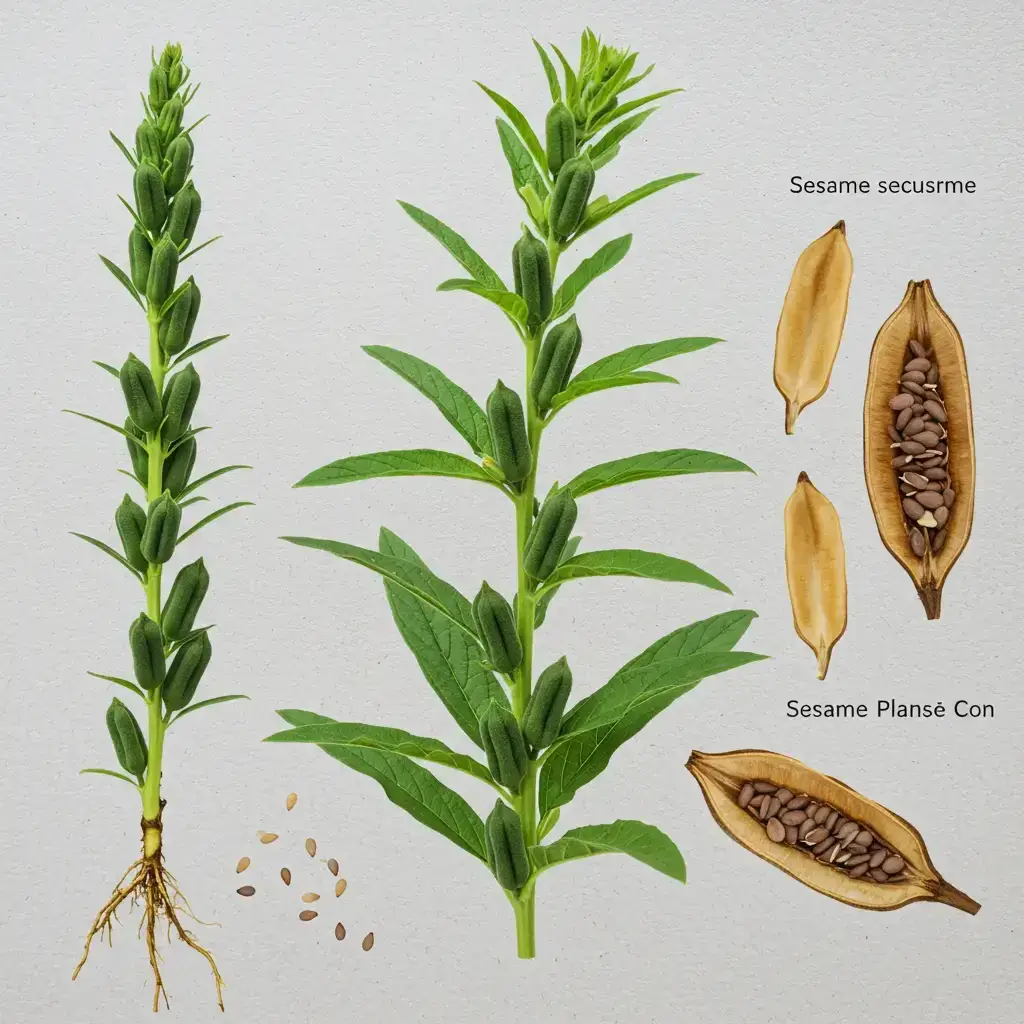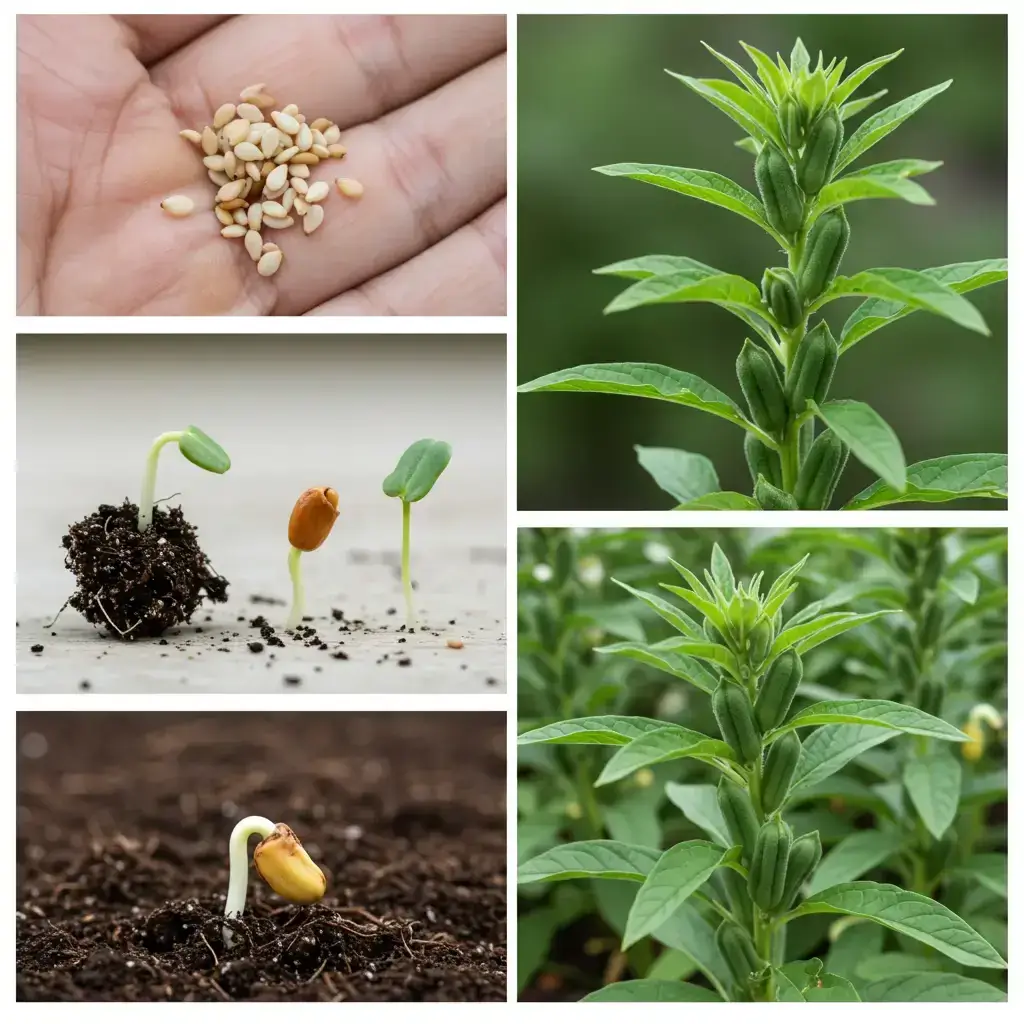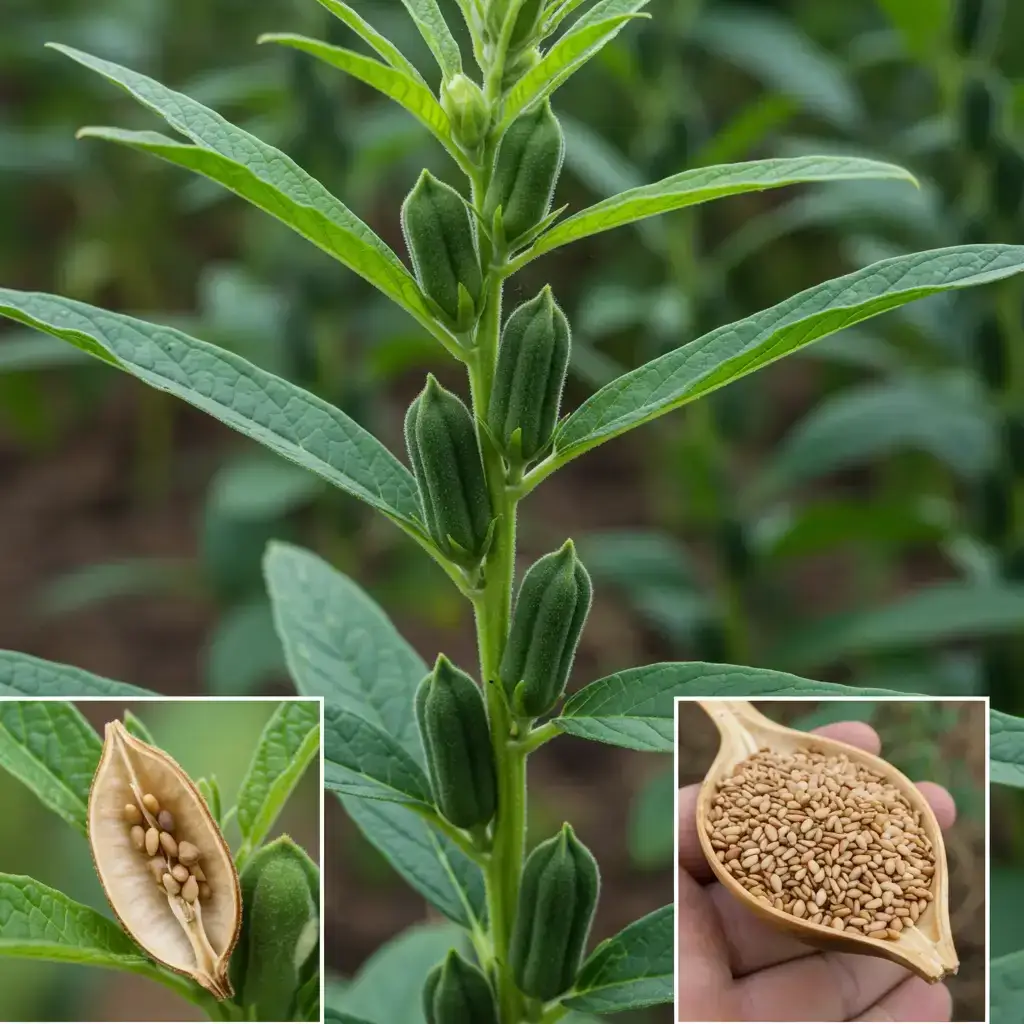What kind of plant do sesame seeds come from?
Sesame seeds come from a tall herb called the sesame seed plant. It’s native to tropical areas. These seeds are loved worldwide for their nutty taste and health benefits.
Learning about sesame seeds connects us to ancient foods and today’s cooking. This article dives into the sesame seed plant’s history, how it grows, and why it’s important. It’s for both gardeners and food lovers.
Introduction to Sesame Seeds and Their Origins
Sesame seeds have traveled far and wide, leaving a mark on food and culture. These small seeds hold a big history, showing us how global diets have evolved.
Historical Context of Sesame Seeds
Sesame seeds have been around for over 3,000 years. They started in places like Mesopotamia and the Indus Valley. Ancient Egyptians used them in bread, and the Chinese mentioned their oil in texts from 1600 BCE.
By the 18th century, sesame seeds were traded worldwide. They became a key ingredient in many cuisines.
Cultural Significance in the United States
In the U.S., sesame seeds have found a special spot in kitchens. They are used in:
- Bagels and hamburger buns for crunch
- Salad toppings and bakery decorations
- Traditional dishes in Southern and immigrant communities
They also symbolize cultural blending. For instance, Japanese goma sauces in American restaurants show their versatility. Farmers’ markets now offer black and white seeds, showing a growing interest in heritage foods.
Understanding What kind of plant do sesame seeds come from
Let’s dive into the world of sesame seeds. We’ll learn about the plant’s scientific name and its physical features. This will help us understand how it grows and produces those small, useful seeds.
Botanical Classification
Sesame plants are known as Sesamum indicum. They belong to the Pedaliaceae family. This family includes plants that can handle drought well. Here are some important facts:
- Genus and species: Sesamum indicum
- Family name: Pedaliaceae
- Alternative names: benne, sesame shrub
Key Plant Characteristics
Here’s what you should look for when spotting sesame plants:
- Height: They can grow 3–6 feet tall, with thin stems
- Leaves: Their leaves are oval and grow in pairs along the stems
- Flowers: They have delicate, tubular blooms in white or purple
- Seed pods: The seed pods are oval and split open when ripe, scattering seeds
These features help sesame plants thrive in warm places. They do well in well-drained soil. Knowing these traits helps us see the plant’s importance in farming and cooking.
Exploring the Sesame Seed Plant: Growth, Features, and Harvesting

Sesame plants love warm weather and grow tall with pods that open when they’re ready. Taking good care of them leads to a big harvest. But, timing is everything. Let’s look at what makes this crop special.
How Are Sesame Seeds Harvested
Harvesting sesame seeds is all about watching the plant’s life cycle. Here’s how it’s done:
- Look for cracked pods—that means the seeds are ready. Waiting too long can cause the pods to burst and lose seeds.
- Use a sharp tool to cut the stalks, then dry them in the sun for 1–2 days. This makes it easier to get the seeds out.
- Use a flail or machine to separate the seeds from the dried pods. Then, winnowing gets rid of any leftover debris, leaving clean seeds.
Small farmers often do it by hand, while big farms use machines for more efficiency. Knowing how are sesame seeds harvested helps get the best yield and quality.
Unique Growth Aspects
Sesame plants have some special traits:
- Heat tolerance: They can handle temperatures up to 95°F, making them perfect for the U.S. Southern states.
- Soil adaptability: They can grow in poor soil, which means they don’t need much fertilizer.
- Self-seeding: When the pods burst, they scatter seeds everywhere, making it easy to grow more plants.
These traits make sesame a hardy crop for both home gardens and big farms.
Sesame Plant Growing Zone and Optimal Climate Conditions
Sesame plants love warm, sunny spots. To grow them well, it’s important to match your area with the right growing zone. They do best in USDA zones 5 through 11, where it’s warm enough for seeds to grow.
Ideal Growing Zones in the US
In the US, the best places for growing sesame are Texas, Oklahoma, Kansas, and parts of California. These areas have long, hot summers perfect for sesame plants. Check your local USDA zone map to see if your garden is in the right zone.
Climate Considerations for Success
For sesame plants to grow well, they need warm weather and lots of sunlight. Here’s what you need to do:
- Temperature: Daytime should be between 80–95°F (27–35°C) during growth.
- Rainfall: They need 20–40 inches of rain a year. Make sure the soil drains well to avoid waterlogging.
- Soil: Use sandy or loamy soil with a pH of 6.0–7.5 for the best nutrient uptake.
“Sesame plants are drought-tolerant but need consistent moisture during flowering,” note agricultural experts. Watch the soil moisture closely during dry times.
Planting at the right time is also crucial. Plant seeds after the last spring frost when the soil is at least 60°F (15.5°C). Adjust how often you water based on your local weather to help seeds grow strong.
How to Grow Sesame Seeds at Home: Tips for Your Garden

Ready to start how to grow sesame seeds at home? Follow these simple steps for a successful harvest. Start by picking a sunny spot with soil that drains well. Sesame plants love warm weather, so wait until after the last frost.
- Prepare the soil: Loosen the ground to 12 inches deep and mix in compost for nutrients. Sesame prefers slightly sandy or loamy soil.
- Plant seeds: Sow ½ inch deep, spacing seeds 3–4 inches apart. Rows should be 18–24 inches wide to allow growth.
- Water wisely: Keep soil moist but not soggy. Reduce watering once plants flower to avoid root rot.
- Watch for maturity: Harvest when seed pods crack open, usually 100–120 days after planting. Shake the pods to hear a rattling sound—a sign they’re ready.
“Consistency in care ensures healthy growth. Patience pays off when growing sesame,” advises gardening expert Sarah Green.
Use these extra tips to boost success:
- Stake tall varieties to prevent wind damage.
- Apply a light layer of mulch to retain moisture.
- Check for aphids or mites weekly and treat early if spotted.
Following these steps turns your backyard into a sesame seed farm. Whether in containers or garden beds, how to grow sesame seeds at home becomes easy with proper care. Enjoy the satisfaction of harvesting your own seeds for cooking or crafts!
Sesame Seed Plant Care and Maintenance
Keeping sesame plants healthy requires regular care. This includes proper watering, nutrient management, and pest control. Follow these steps to grow strong plants in your garden.
Watering and Fertilization Strategies
Start with deep watering once a week. Let the soil dry a bit before watering again. This prevents root rot.
Use a balanced fertilizer (like 10-10-10 NPK) when plants are young. But don’t overdo it, as too much can harm the leaves. Organic compost is great for soil health without harsh chemicals.
Pest and Disease Management
Check your plants often to spot problems early. Aphids and fungal diseases like damping-off are common. Here’s how to handle them:
- Look for pests or yellow spots on leaves every day.
- Use insecticidal soap to fight aphids.
- Thin out seedlings to improve air flow and lower disease risk.
- Change where you plant each year to break pest cycles.
“Consistent monitoring is key to preventing sesame plant stress.” — USDA Agricultural Research Service
By following these care tips, your sesame plants will be more resilient. Adjust your methods based on your local climate, as mentioned in Sesame Seed Plant Growing Zone and Optimal Climate Conditions. Focus on soil health and stay alert for the best results.
Conclusion
The sesame plant’s journey from seed to harvest is fascinating. It shows its special place in agriculture and culture. This ancient crop, Sesamum indicum, grows best in warm places and needs careful care for soil and pests.
Whether you’re growing it in a small garden or learning about its history, every detail is important. Choosing the right growing zone and proper watering are key for a good harvest. These steps help grow tiny, nutrient-rich seeds.
Learning to grow sesame seeds at home is a unique experience. You’ll need to follow tips on sunlight, moisture, and timing. This way, you can nurture this versatile plant.
Sesame’s global importance, from food to traditional practices, shows its lasting value. By applying these tips, you might want to try growing other crops or learn more about their backgrounds. The sesame plant’s story teaches us about nature’s diversity and the science behind our food. Start your sesame journey today and uncover its hidden potential.
FAQ About Sesame seeds
What kind of plant do sesame seeds come from?
Sesame seeds come from the sesame seed plant, known as *Sesamum indicum*. This plant is from Africa and India. It’s famous for its small, oily seeds used in cooking and baking.
How are sesame seeds harvested?
Sesame seeds are harvested when the plant is fully dry. The seed pods turn brown and dry. Then, they are picked and threshed to get the seeds. This process is hard work, especially for big fields.
What is the sesame plant growing zone?
The sesame plant grows best in zones 9 through 11 in the U.S. It needs a warm climate, lots of sunlight, and well-draining soil.
What are the best practices for sesame seed plant care?
For good care, water consistently, especially when it’s dry. Use organic fertilizers and watch out for pests. Also, manage weeds to keep your plants healthy.
How can I grow sesame seeds at home?
To grow sesame seeds at home, pick a sunny spot with good drainage. Plant seeds after the last frost, keeping the soil moist. Water and weed regularly to help them grow.
What unique growth aspects should I know about the sesame plant?
The sesame plant has a strong taproot and can handle drought well. It grows 2 to 4 feet tall. It also has beautiful, tubular flowers that turn into seed pods.
What climate conditions are ideal for sesame seed cultivation?
The best climate for sesame seeds is warm, between 70°F and 100°F. Low humidity and good air circulation help. Rainfall during the growing season is also key for a good harvest.
How do I manage pests and diseases for my sesame plants?
To manage pests and diseases, use crop rotation and keep the soil healthy. Regularly check your plants. Organic pesticides can also help keep your plants safe.

